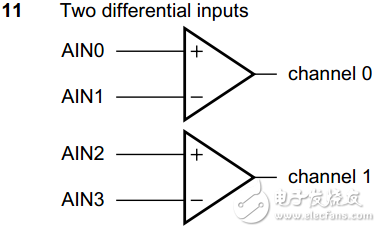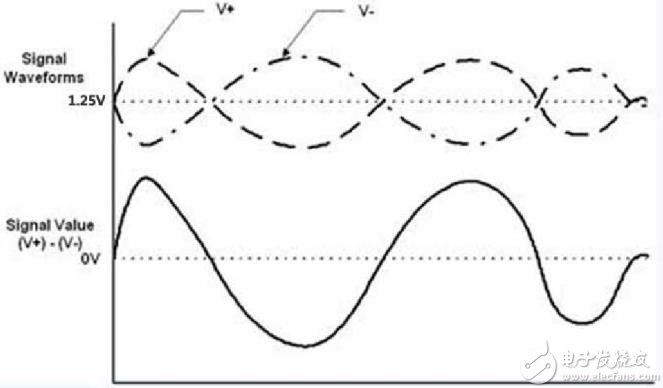What is the differential input principle? How big is the reference voltage?
The 4th and 5th bits of the control word in the PCF8591 are used to configure whether the analog input is in single-ended or differential mode. While single-ended inputs use a common ground reference, differential inputs offer greater noise immunity by measuring the difference between two signals. This technique is widely used in precision analog systems where signal integrity is crucial.
Technically speaking, all voltages are relative to another point, so every signal can be considered a differential signal. However, in most systems, we use a fixed reference point—usually GND. For differential A/D input, there are typically two inputs with equal amplitude but opposite polarity. Think of it like a seesaw: when one side goes up, the other goes down. This setup helps cancel out external noise that affects both lines equally.
As shown in Figure 17-8, the differential input mechanism works by taking the difference between two signals. The PCF8591 has four analog input channels that can be configured in various modes, including a two-channel differential configuration. This is one of the most commonly used settings, as illustrated in Figure 17-9.


When both the 4th and 5th bits of the control word are set to 1, the four analog inputs are configured as two differential channels: channel 0 and channel 1. For example, in channel 0, AIN0 acts as the positive input, while AIN1 is the negative input. The actual signal being measured is the difference between these two inputs, as shown in Figure 17-10.

Figure 17-10 Differential Input Signal
In this setup, the neutral line (or common mode voltage) is usually half of the reference voltage. If the reference voltage is 2.5 V, then the neutral line would be around 1.25 V. V+ represents the signal at AIN0, while V- represents the signal at AIN1. The resulting signal after subtraction is what gets converted by the ADC.
Differential inputs are preferred in many applications because they are more resistant to noise. In a single-ended system, if one wire picks up interference, the measurement will be affected. But with a differential setup, external noise tends to affect both wires equally. Since the system only measures the difference between them, the noise cancels out. Additionally, the opposing polarities help reduce electromagnetic interference, making the system more robust in noisy environments.
Although our KST-51 development board doesn’t have a dedicated setup for testing differential signals, understanding this concept is essential for anyone working with analog-to-digital conversion. It’s a fundamental topic that improves your ability to design more reliable and accurate analog systems.
Our Earth anchors are made of high quality steel with a center or offset eye and helix plate.
An integral forged eye anchor with a helix welded to the shaft and for manual or machine.
Manual installations accomplished by inserting a bar through the eye and screwing the anchor down in line with the guy.
We can supply each earth anchor with high quality and best price for you.
The color of Earth anchor can be choose by your own love,we can make one or two helix Screw Piles on pole as your requirements.
The use of pile anchor is widely distributed and the application is very mature.Earth anchor for road and traffic sign,Earth anchor for timber construction and sheds,Earth anchor for park and city building,Earth anchor for flag poles and banners,Earth anchor for Solar Energy System.The surface of our Pile anchor is treated with hot dip galvanizing,which can achieve no rust for more than 15 years,and the Pile anchor can be reused,reducing environmental damage and saving costs,which is why our Pile anchor are popular.
Steel Ground Spike,Earth Spike,Pile Anchor,Helical Ground Anchor,Square Anchor
BAODING JIMAOTONG IMPORT AND EXPORT CO., LTD , https://www.chinagroundscrew.com
